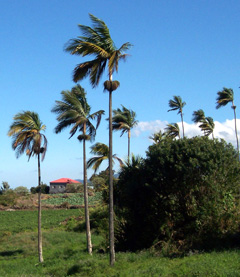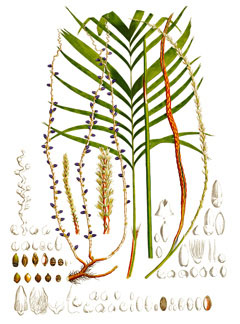 |
|
https://edibleplants.org/ |
 |
| https://edibleplants.org/ |
Translate this page:
Summary
Hurricane Palm (Dictyosperma album), otherwise known as Princess Palm or Red Palm, is a single-stemmed, slender, evergreen feather palm that reaches a height of up to 20 m and up to 16 cm in diameter. The crown is composed of 10 to 20 leaves with each leaf measuring up to 3 m long. Hurricane Palm is very attractive hence it is also grown as an ornamental in the tropics and subtropics. It is commonly found in Africa specifically in Mauritius and Reunion. Root decoction is a diuretic. The leaves and apical bud can both be cooked and consumed.
Physical Characteristics

 Dictyosperma album is an evergreen Tree growing to 15 m (49ft) by 8 m (26ft) at a fast rate.
Dictyosperma album is an evergreen Tree growing to 15 m (49ft) by 8 m (26ft) at a fast rate.
See above for USDA hardiness. It is hardy to UK zone 10.
Suitable for: light (sandy), medium (loamy) and heavy (clay) soils and prefers well-drained soil. Suitable pH: neutral and basic (mildly alkaline) soils and can grow in saline soils.
It can grow in semi-shade (light woodland) or no shade. It prefers moist soil. The plant can tolerate maritime exposure.
UK Hardiness Map
US Hardiness Map
Synonyms
Areca alba Bory Areca aurea Van Houtte Areca borbonica Kunth Areca furfuracea H.Wendl. Areca lactea
Plant Habitats
Edible Uses
Edible Parts: Apical bud Leaves
Edible Uses:
Leaves - cooked[ 299 ]. The apical bud of this plant is highly valued as a food[ 299 ]. This palm is single-stemmed and unable to form sideshoots - harvesting the apical bud leads to the death of the plant[ K ].
References More on Edible Uses
Medicinal Uses
Plants For A Future can not take any responsibility for any adverse effects from the use of plants. Always seek advice from a professional before using a plant medicinally.
Diuretic
A root decoction is used as a diuretic[ 299 ].
References More on Medicinal Uses
The Bookshop: Edible Plant Books
Our Latest books on Perennial Plants For Food Forests and Permaculture Gardens in paperback or digital formats.

Edible Tropical Plants
Food Forest Plants for Hotter Conditions: 250+ Plants For Tropical Food Forests & Permaculture Gardens.
More

Edible Temperate Plants
Plants for Your Food Forest: 500 Plants for Temperate Food Forests & Permaculture Gardens.
More

More Books
PFAF have eight books available in paperback and digital formats. Browse the shop for more information.
Shop Now
Other Uses
References More on Other Uses
Cultivation details
Plants are able to tolerate occasional light frosts with temperatures down to -1°c[ 423 ]. Prefers a position in light shade or full sun[ 299 , 314 ]. Grows best in a well-drained soil. Tolerant of saline conditions[ 299 , 314 ]. Usually growing near the coast, the plant can withstand the strongest of winds, including salt-laden hurricanes[ 299 , 314 ]. A moderately fast growing plant[ 299 ]. Blooms repeatedly
References Carbon Farming Information and Carbon Sequestration Information
Temperature Converter
Type a value in the Celsius field to convert the value to Fahrenheit:
Fahrenheit:
The PFAF Bookshop
Plants For A Future have a number of books available in paperback and digital form. Book titles include Edible Plants, Edible Perennials, Edible Trees,Edible Shrubs, Woodland Gardening, and Temperate Food Forest Plants. Our new book is Food Forest Plants For Hotter Conditions (Tropical and Sub-Tropical).
Shop Now
Plant Propagation
Seed - sown fresh, it germinates within 60 - 120 days[ 423 ].
Other Names
If available other names are mentioned here
Native Range
AFRICA: Mauritius, Reunion
Weed Potential
Right plant wrong place. We are currently updating this section.
Please note that a plant may be invasive in one area but may not in your area so it's worth checking.
Conservation Status
IUCN Red List of Threatened Plants Status : This taxon has not yet been assessed.

Growth: S = slow M = medium F = fast. Soil: L = light (sandy) M = medium H = heavy (clay). pH: A = acid N = neutral B = basic (alkaline). Shade: F = full shade S = semi-shade N = no shade. Moisture: D = dry M = Moist We = wet Wa = water.
Now available:
Food Forest Plants for Mediterranean Conditions
350+ Perennial Plants For Mediterranean and Drier Food Forests and Permaculture Gardens.
[Paperback and eBook]
This is the third in Plants For A Future's series of plant guides for food forests tailored to
specific climate zones. Following volumes on temperate and tropical ecosystems, this book focuses
on species suited to Mediterranean conditions—regions with hot, dry summers and cool, wet winters,
often facing the added challenge of climate change.
Read More
Expert comment
Author
(Bory) Scheff.
Botanical References
Links / References
For a list of references used on this page please go here
A special thanks to Ken Fern for some of the information used on this page.
Readers comment
| Add a comment |
|
If you have important information about this plant that may help other users please add a comment or link below. Only comments or links that are felt to be directly relevant to a plant will be included. If you think a comment/link or information contained on this page is inaccurate or misleading we would welcome your feedback at [email protected]. If you have questions about a plant please use the Forum on this website as we do not have the resources to answer questions ourselves.
* Please note: the comments by website users are not necessarily those held by PFAF and may give misleading or inaccurate information.
To leave a comment please Register or login here All comments need to be approved so will not appear immediately.
|
Subject : Dictyosperma album
|
|
|
|